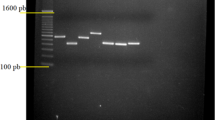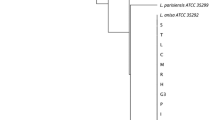Abstrac
Legionellosis (Legionnaires’ disease; LD) is a form of severe pneumonia caused by species of Legionella bacteria. Because inhalation of Legionella-contaminated aerosol is considered the major infection route, routine assessments of potential infection sources such as hot water systems, air-conditioner cooling water, and municipal fountains are of great importance. In this study, we utilized in vitro culture and multilocus sequence analysis (MLSA) targeting 16S rRNA, mip, rpoB, and mip-rpoB concatenation to isolate and identify Legionella spp. from 5 municipal fountains in Chengdu City, Sichuan Province, China. Our results demonstrated that 16S rRNA was useful for initial identification, as it could recognize isolates robustly at the genus level, while the genes mip, rpoB, and mip-rpoB concatenation could confidently discriminate Legionella species. Notably, the three subspecies of L. pneumophila could be distinguished by the analysis based on rpoB. The serotyping result of strain CD-1 was consistent with genetic analysis based on the concatenation of mip and rpoB. Despite regular maintenance and sanitizing methods, 4 of the 5 municipal fountains investigated in this study were positive for Legionella contamination. Thus, regularly scheduled monitoring of municipal fountains is urgently needed as well as vigilant disinfection. Although the application of MLSA for inspection of potential sites of infection in public areas is not standard procedure, further investigations may prove its usefulness.
Similar content being viewed by others
References
Akaike, H. 1974. A new look at the statistical model identification. IEEE. Trans. Automatic. Control. 19, 716–723.
Anand, C.M., Skinner, A.R., Malic, A., and Kurtz, J.B. 1983. Interaction of L. pneumophila and a free living amoeba (Acanthamoeba palestinensis). J. Hyg. Camb. 91, 167–178.
Bangsborg, J.M., Shand, G., Pearlman, E., and Hoiby, N. 1991. Cross-reactive Legionella antigens and the antibody response during infection. APMIS 99, 854–865.
Barabee, J.M., Gowman, G.W., Martin, W.T., Fields, B.S., and Morrill, W.E. 1987. Protocol for sampling environmental sites for legionellae. Appl. Environ. Microbiol. 53, 1454–1458.
Bartie, C., Vente, S.N., and Nel, L.H. 2003. Identification methods for Legionella from environmental samples. Water Res. 37, 1362–1370.
Blanco, S., Prat, C., Sanchez, M.D., Ferrer, D., Pellicer, T., Haba, L., Latorre, I., Vilaplana, C., Ausina, V., and Dominguez, J. 2008. Evaluation of a Legionella urinary antigen enzyme immunoassay for rapid detection of Legionella pneumophila in water samples. Int. J. Hyg. Envir. Health 211, 168–171.
Boswell, T.C. 1996. Serological cross reaction between Legionella and campylobacterin the rapid microagglutination test. J. Clin. Pathol. 49, 584–586.
Brenner, D.J. 1986. Classification of Legionellaceae: current status and remaining questions. Isr. J. Med. Sci. 22, 620–632.
Brenner, D.J., Steigerwalt, A.G., Epple, P., Bibb, F.W., Mckinney, R.M., Starnes, R.W., Colville, J.M., Selander, R.M., and Edelstein, P.H. 1988. Legionella pneumophila serogroup Lansing 3 isolated from a patient with fatal pneumonia, and description of L. pneumophila subsp. pneumophila subsp. nov., L. pneumophila subsp. fraseri subsp. nov., and L. pneumophila subsp. pascullei subsp. nov. J. Clin. Microbiol. 26, 1695–1703.
Cianciotto, N.P., Eisenstein, B.I., Mody, C.H., Toews, G.B., and Engleberg, N.C. 1989. A Legionella pneumophila gene encoding a species-specific surface protein potentiates initiation of intracellular infection. Infect. Immun. 57, 1255–1262.
Clayton, R.A., Sutton, G., Hinkle, P.S., Bult, C., and Fields, C. 1995. Intra specific variation in small-subunit rRNA sequences in GenBank, why single sequences may not adequately represent prokaryotic taxa. Int. J. Syst. Bacteriol. 45, 595–599.
Cooper, I.R., White, J., Mahenthiralingam, E., and Hanlon, G.W. 2008. Long-term persistence of a single Legionella pneumophila strain possessing the mip gene in a municipal shower despite repeated cycles of chlorination. J. Hosp. Infect. 70, 154–159.
Coscolla, M., Fenolla, J., Escribano, I., and Gonzalez-Candelas, F. 2010. Legionellosis outbreak associated with asphalt paving machine, Spain, 2009. Emerg. Infect. Dis. 16, 1381–1387.
Dahllof, I., Baillie, H., and Kjelleberg, S. 2000. RpoB-based microbial community analysis avoids limitations inherent in 16S rRNA gene intraspecies heterogeneity. Appl. Environ. Microbiol. 66, 3376–3380.
Declerk, P., Behets, J., Lammertyn, E., Labeau, I., Anne, J., and Ollevier, F. 2005. Detection and quantification of Legionella pneumophila in water samples using competitive PCR. Can. J. Microbiol. 52, 584–590.
Doyle, R.M., Steele, T.W., McLennan, A.M., Parkinson, I.H., Manning, P.A., and Heuzenroeder, M.W. 1998. Sequence analysis of the mip gene of the soilborne pathogen Legionella longbeachae. Infect. Immun. 66, 1492–1499.
Edelstein, P.H. 2007. Legionella. In Murray, P.R., Baron, E.J., Jorgensen, J.H., Landry, M.L., and Pfalle, M.A. (eds.), Manual of clinical microbiology, pp. 835–849. 9th ed. ASM Press, Washington, D.C., USA.
Euser, S.M., Pelgrim, M., and Den Boer, J.W. 2010. Legionnaires’ disease and Pontiac fever after using a private outdoor whirl pool spa. Scand. J. Infect. Dis. Epub. 42, 910–916.
Fields, B.S., Benson, R.F., and Besser, R.E. 2002. Legionella and Legionnaires’ disease, 25 years of investigation. Clin. Microbiol. Rev. 15, 506–526.
Fields, B.S., Shotts, E.B., Feeley, J.C., Gorman, G.W., and Martin, W.T. 1984. Proliferation of Legionella pneumophila as an intracellular parasite of the ciliated protozoan Tetrahymena pyriformis. Appl. Environ. Microbiol. 47, 467–471.
Fry, N.K., Warwick, S., Saunders, N.A., and Embley, T.M. 1991. The use of 16S ribosomal RNA analyses to investigate the phylogeny of the family Legionellaceae. J. Gen. Microbiol. 137, 215–222.
Gomez-Valero, L., Rusniok, C., and Buchrieser, C. 2009. Legionella pneumophila, population genetics, phylogeny and genomics. Infect. Genet. Evol. 9, 727–739.
Hacker, J. and Fischer, G. 1993. Immunophilins, structure-function relationship and possible role in microbial pathogenicity. Mol. Microbiol. 10, 445–456.
Helbig, J.H., Bernander, S., Castellani Pastoris, M., Etienne, J., Gaia, V., Lauwers, S., Lindsay, D., Lück, P.C., Marques, T., Mentula, S., and et al. 2002. Pan-European study on culture-proven Legionnaires’ disease, distribution of Legionella pneumophila serogroups and monoclonal subgroups. Eur. J. Clin. Microbiol. Infect. Dis. 21, 710–716.
Hoge, C.W. and Breiman, R.F. 1991. Advances in the epidemiology and control of Legionella. Epidemiol. Rev. 13, 329–335.
Holmes, E.C., Urwin, R., and Maiden, M.C.J. 1999. The influence of recombination on the population structure and evolution of the human pathogen Neisseria meningitidis. Mol. Biol. Evol. 16, 741–749.
Huelsenbeck, J.P., Larget, B., Miller, R.E., and Ronquist, F. 2002. Potential applications and pitfalls of Bayesian inference of phylogeny. Syst. Biol. 51, 673–688.
Joseph, C.A., Ricketts, K.D., Yadav, R., and Patel, S., on behalf of the European Working Group for Legionella Infections. 2010. Travel-associated Legionnaires’ disease in Europe in 2009. Euro. Surveill. 15, 19683.
Kim, B.J., Lee, S.H., Lyu, M.A., Kim, S.J., Bai, G.H., Kim, S.S., Chae, G.T., Kim, E.C., Cha, C.Y., and Kook, Y.H. 1999. Identification of mycobacterial species by comparative sequence analysis of the RNA polymerase gene (rpoB). J. Clin. Microbiol. 37, 1714–1720.
Ko, K.S., Lee, H.K., Park, M.Y., Lee, K.H., Yun, Y.J., Woo, S.Y., Miyamoto, H., and Kook, Y.H. 2002. Application of RNA polymerase beta-subunit gene (rpoB) sequences for the molecular differentiation of Legionella species. J. Clin. Microbiol. 40, 2653–2658.
Kuroki, H., Miyamoto, H., Fukuda, K., Iihara, H., Kawamura, Y., Ogawa, M., Wang, Y., Ezaki, T., and Taniguchi, H. 2007. Legionella impletisoli sp. nov. and Legionella yabuuchiae sp. nov., isolated from soils contaminated with industrial wastes in Japan. Syst. Appl. Microbiol. 30, 273–279.
Luck, P.C., Igel, L., Helbig, J.H., Kuhlisch, E., and Jaztzwauk, L. 2004. Comparison of commercially available media for the recovery of Legionella species. Int. J. Hyg. Environ. Health 207, 589–593.
Mathys, W., Stanke, J., Harmuth, M., and Jungle-Mathys, E. 2008. Occurence of Legionella in hot water system of single-family residences in suburbs of two German cities with special reference to solar and district heating. Int. J. Hyg. Environ. Health 211, 179–185.
Mollet, C., Drancourt, M., and Raoult, D. 1997. RpoB sequence analysis as a novel basis for bacterial identfication. Mol. Microbiol. 26, 1005–1011.
Newton, H.J., Ang, D.K., van Driel, I.R., and Hartland, E.L. 2010. Molecular pathogenesis of infections caused by Legionella pneumophila. Clin. Microbiol. Rev. 23, 274–298.
O’Connell, W.A., Dhand, L., and Cianciotto, N.P. 1996. Infection of macrophage-like cells by Legionella species that have not been associated with disease. Infect. Immun. 64, 4381–4384.
Page, R.D.M. 1996. TREEVIEW, an application to display phylogenetic trees on personal computers. CABIOS 12, 357–358.
Palmore, T.N. and Stock, F. 2009. A cluster of nosocomial Legionnaires’ disease linked to a contaminated hospital decorative water fountain. Infect. Control. Hosp. Epidemiol. 30, 764–768.
Posada, D. and Buckley, T.R. 1998. Modeltest, testing the model of DNA substitution. Bioinfomatics 14, 817–818.
Posada, D. and Buckley, T.R. 2004. Model selection and model averaging in phylogenetics advantages of Akaike information criterion and Bayesian approach. Syst. Biol. 53, 793–808.
Qu, P., Deng, X., Zhang, J., Chen, J., Zhang, J., Zhang, Q., Xiao, Y., and Chen, S. 2009. Identification and characterization of the Francisella spp. strain 08HL01032 isolated in air condition systems. Acta. Microbiologica. Sinica. 49, 1003–1010.
Ratcliff, R.M., Lanser, J.A., Manning, P.A., and Heuzenroeder, M.W. 1998. Sequence-based classification scheme for the genus Legionella targeting the mip gene. J. Clin. Microbiol. 36, 1560–1567.
Ronquist, F. and Huelsenbeck, J.P. 2003. Mrbayes 3, Bayesian phylogenic inference under mixed models. Bioinformatics 19, 1572–2574.
Rowbotham, T.J. 1986. Current views on the relationships between amoebae, legionellae and man. Isr. J. Med. Sci. 22, 678–689.
Rubin, C.J., Thollesson, M., Kirsebom, L.A., and Herrmann, B. 2005. Phylogenetic relationships and species differentiation of 39 Legionella species by sequence determination of the RNase P RNA gene rnpB. J. Syst. Bacteriol. 55, 2039–2049.
Severinov, K., Mustaev, A., Kukarin, A., Muzzin, O., Bass, I., Darst, S.A., and Goldfarb, A. 1996. Structural modules of the large subunits of RNA polymerase. J. Biol. Chem. 271, 27969–27974.
Steele, T.W., Lanser, J., and Sangster, N. 1990. Isolation of Legionella longbeachae serogroup1 from potting mixes. Appl. Environ. Microbiol. 56, 49–53.
Sussman, M. 2002. Molecular medical microbiology. Academic Press, Inc., London, England.
Swofford, D.L. 2002. PAUP*. Phylogenetic analysis using parsimony (* and other methods), version 4. Sinauer, Sunderland, MA, USA.
Tamura, K., Dudley, J., Nei, M., and Kumar, S. 2007. MEGA4, Molecular Evolutionary Genetics Analysis (MEGA) software version 4.0. Mol. Bio. Evol. 24, 1596–1599.
Thompson, J.D., Plewniak, F., Jeanmougin, F., and Higgins, D.G. 1997. The Clustal X Windows interface, flexible strategies for multiple sequence alignment aided by quality analysis tools. Nucleic Acids Res. 25, 4876–4882.
Tyndall, R.L. and Domingue, E.L. 1982. Cocultivation of Legionella pneumophila and free-living amoebae. Appl. Environ. Microbiol. 44, 954–959.
Ueda, K., Seki, T., Kudo, T., Yoshida, T., and Kataoka, M. 1999. Two distinct mechanisms cause heterogeneity of 16S rRNA. J. Bacteriol. 181, 78–82.
Wilson, D.A., Reischl, U., Hall, G.S., and Procop, G.W. 2007. Use of partial 16S rRNA gene sequencing for identification of Legionella pneumophila and non-pneumophila Legionella spp. J. Clin. Microbiol. 45, 257–258.
Yu, V.L., Plouffe, J.F., Pastoris, M.C., Stout, J.E., Schousboe, M., Widmer, A., Summersgill, J., File, T., Heath, C.M., Paterson, D.L., and et al. 2002. Distribution of Legionella species and serogroups isolated by culture in patients with sporadic community-acquired legionellosis, an international collaborative survey. J. Infect. Dis. 186, 127–128.
Author information
Authors and Affiliations
Corresponding author
Rights and permissions
About this article
Cite this article
Guan, W., Xu, Y., Chen, Dl. et al. Application of multilocus sequence analysis (MLSA) for accurate identification of Legionella spp. Isolated from municipal fountains in Chengdu, China, based on 16S rRNA, mip, and rpoB genes. J Microbiol. 50, 127–136 (2012). https://doi.org/10.1007/s12275-012-1243-1
Received:
Accepted:
Published:
Issue Date:
DOI: https://doi.org/10.1007/s12275-012-1243-1




